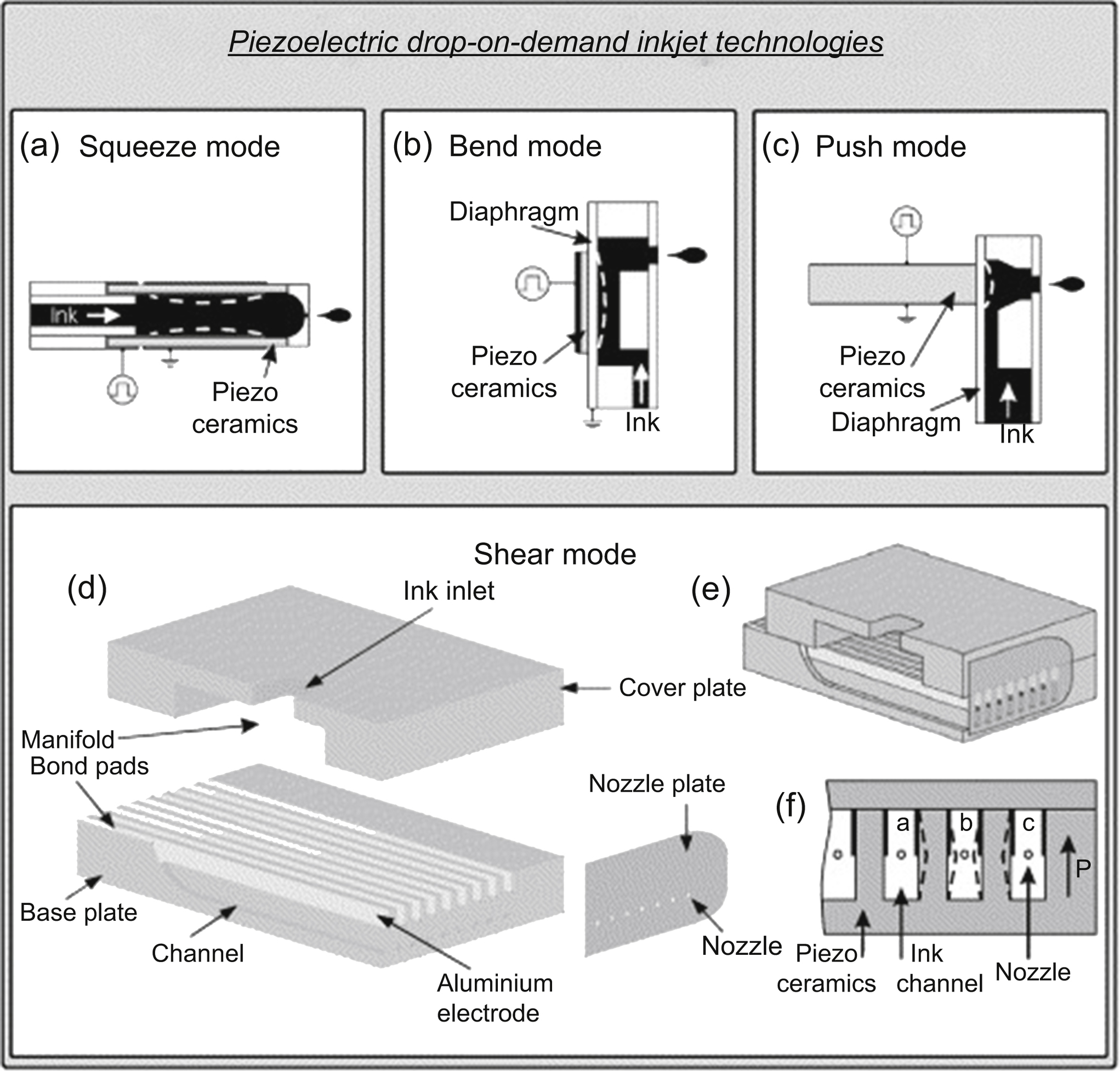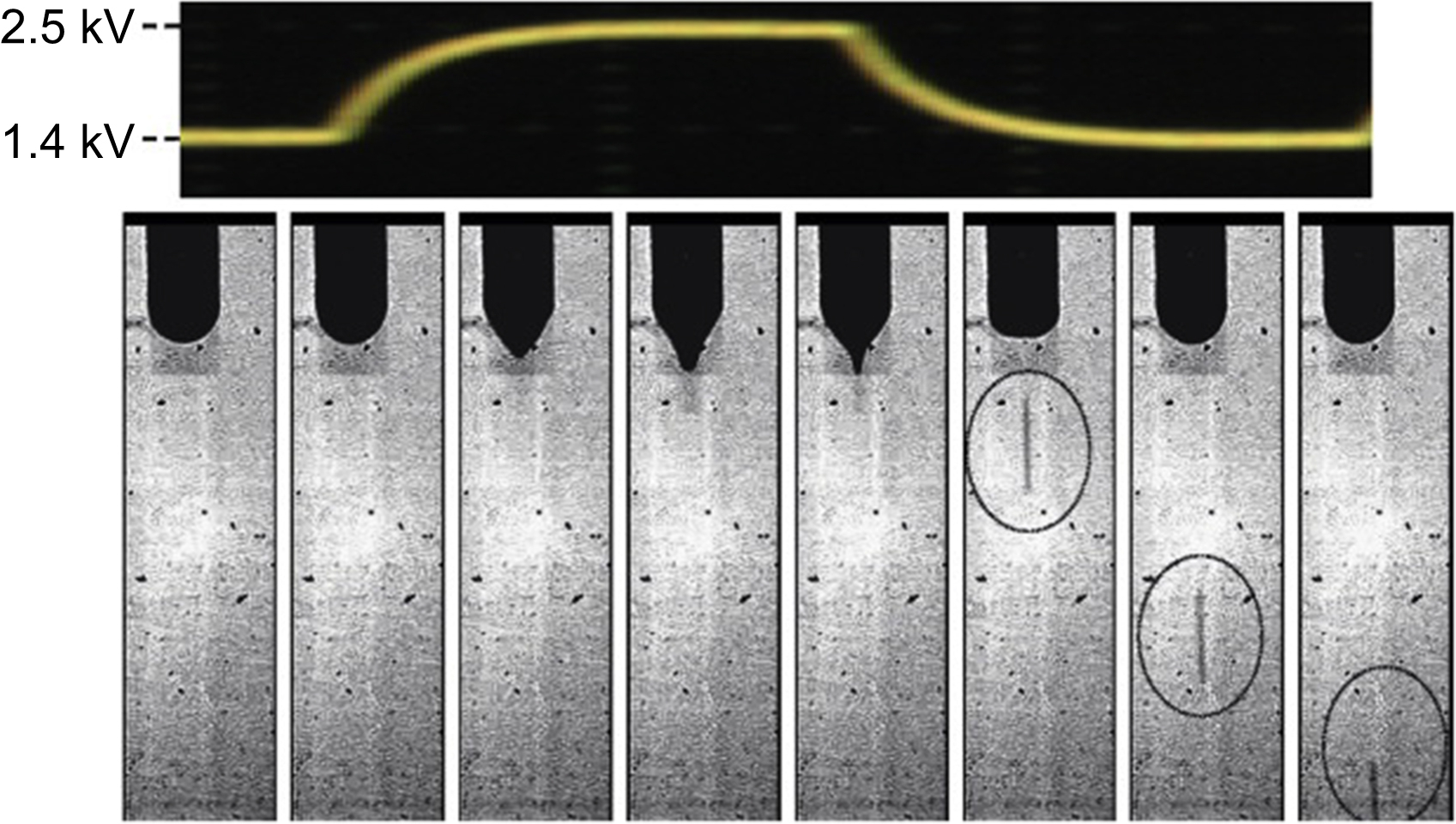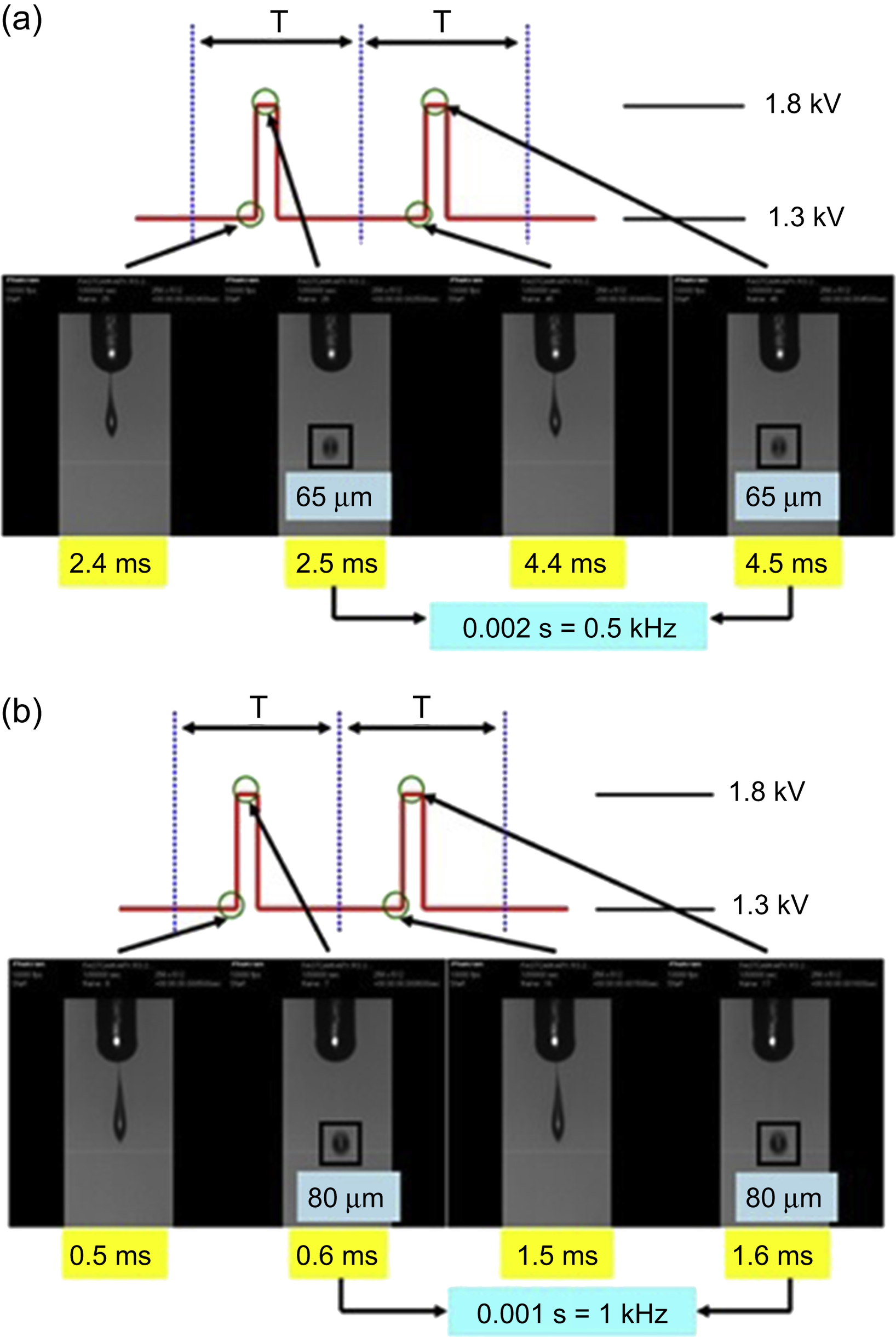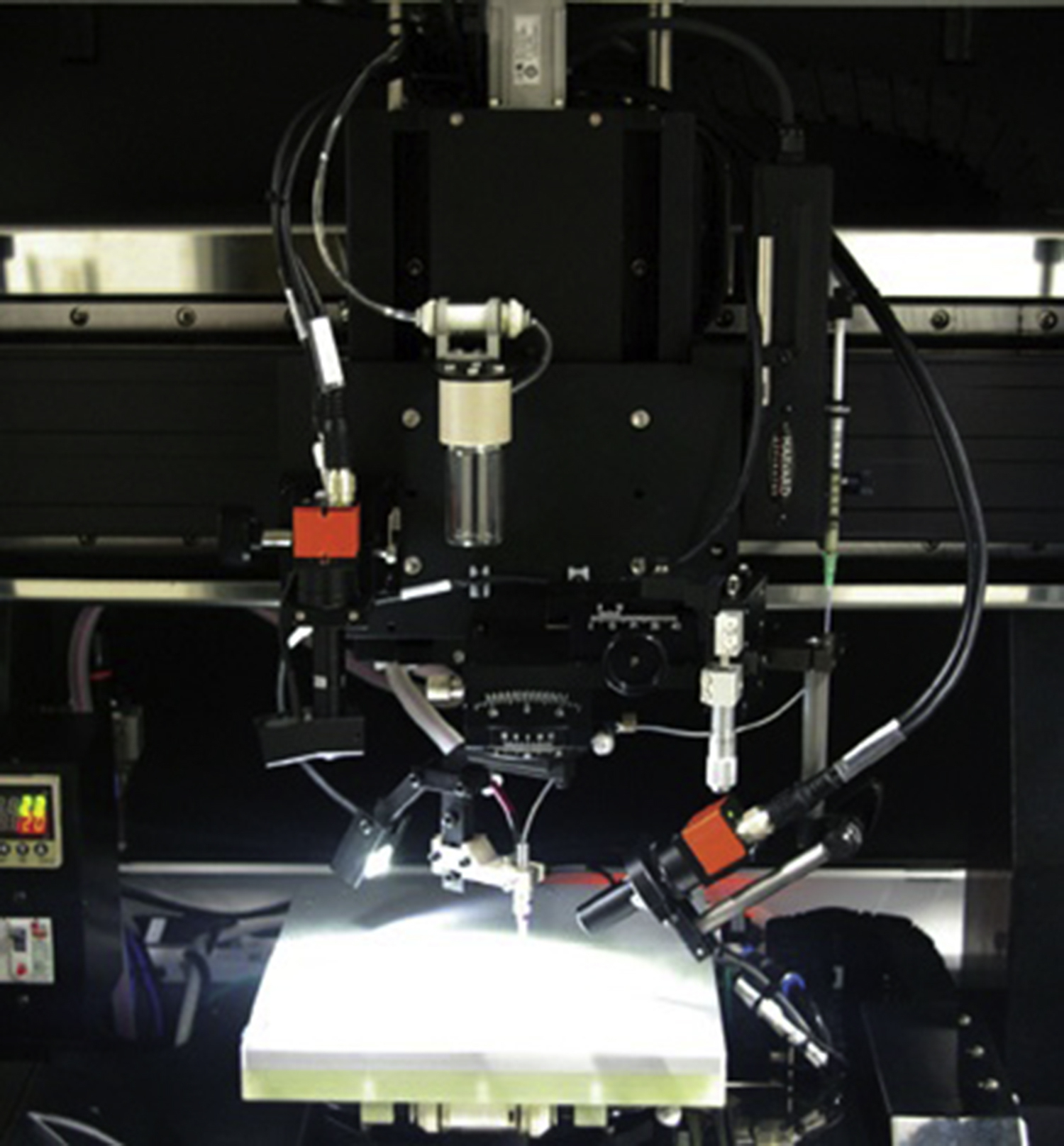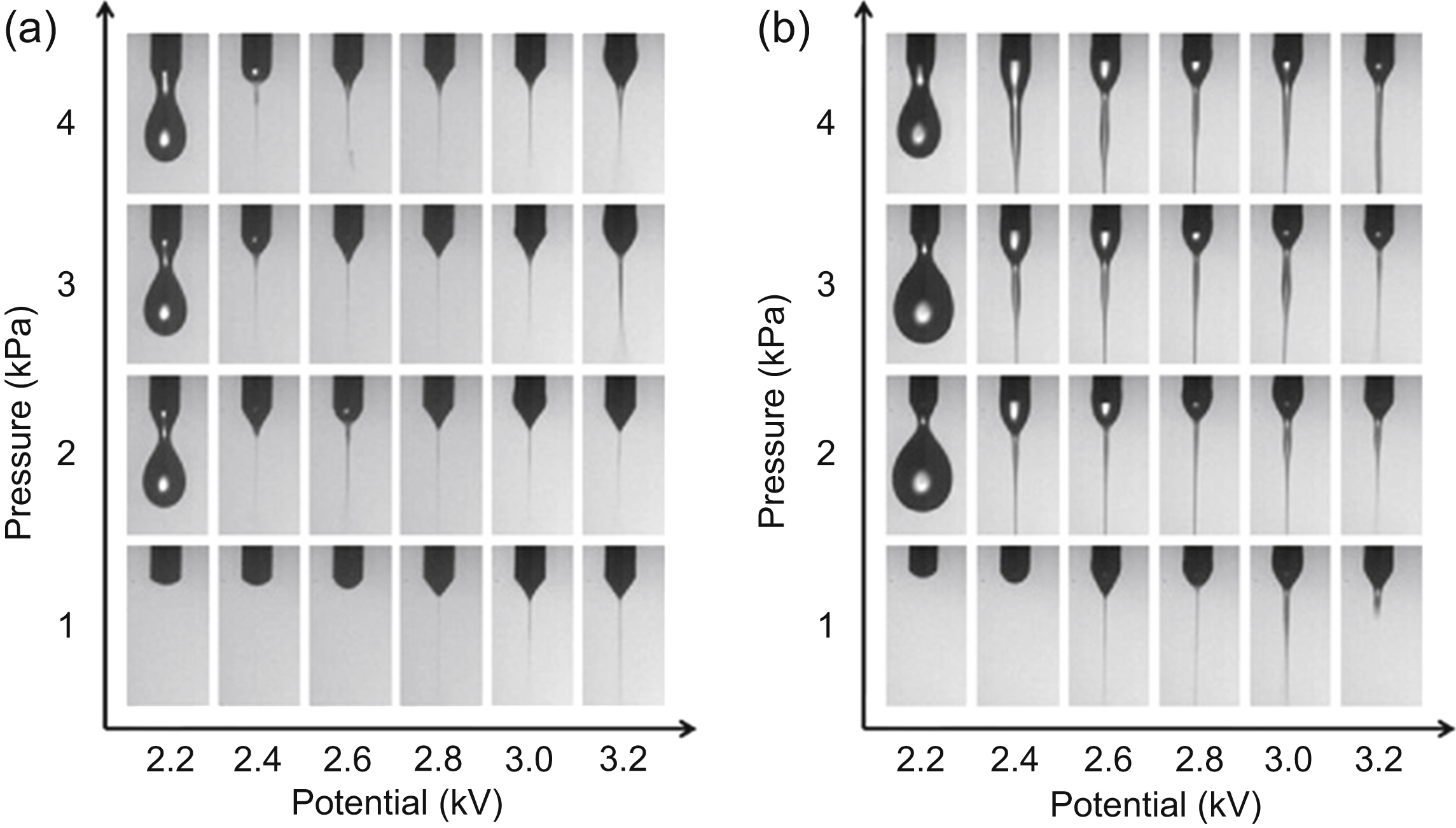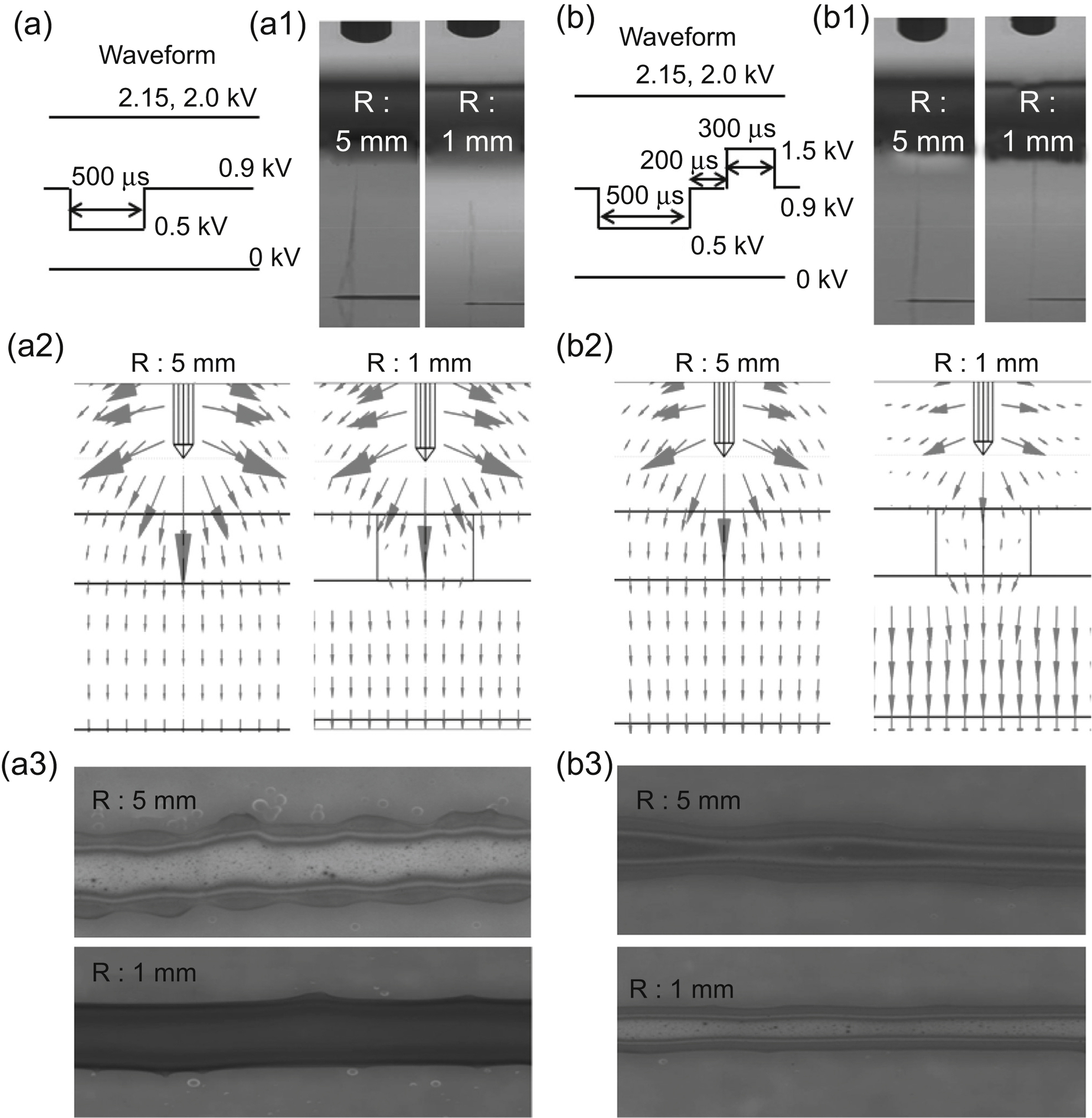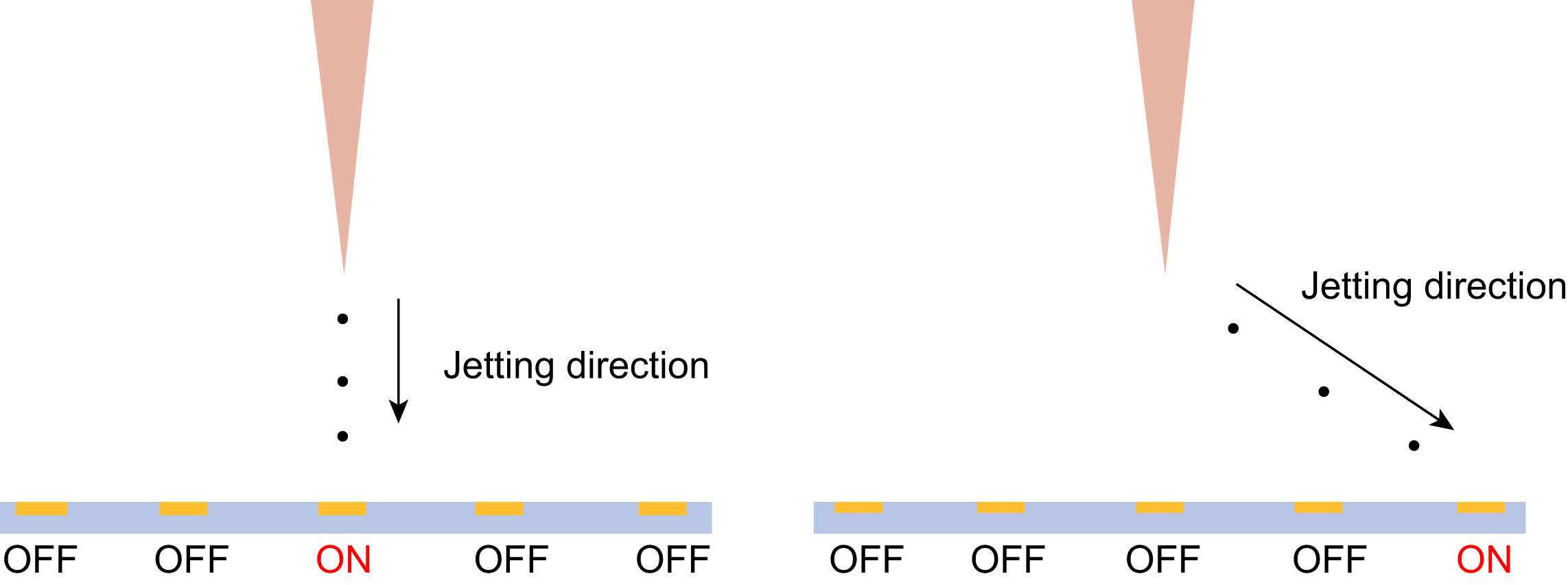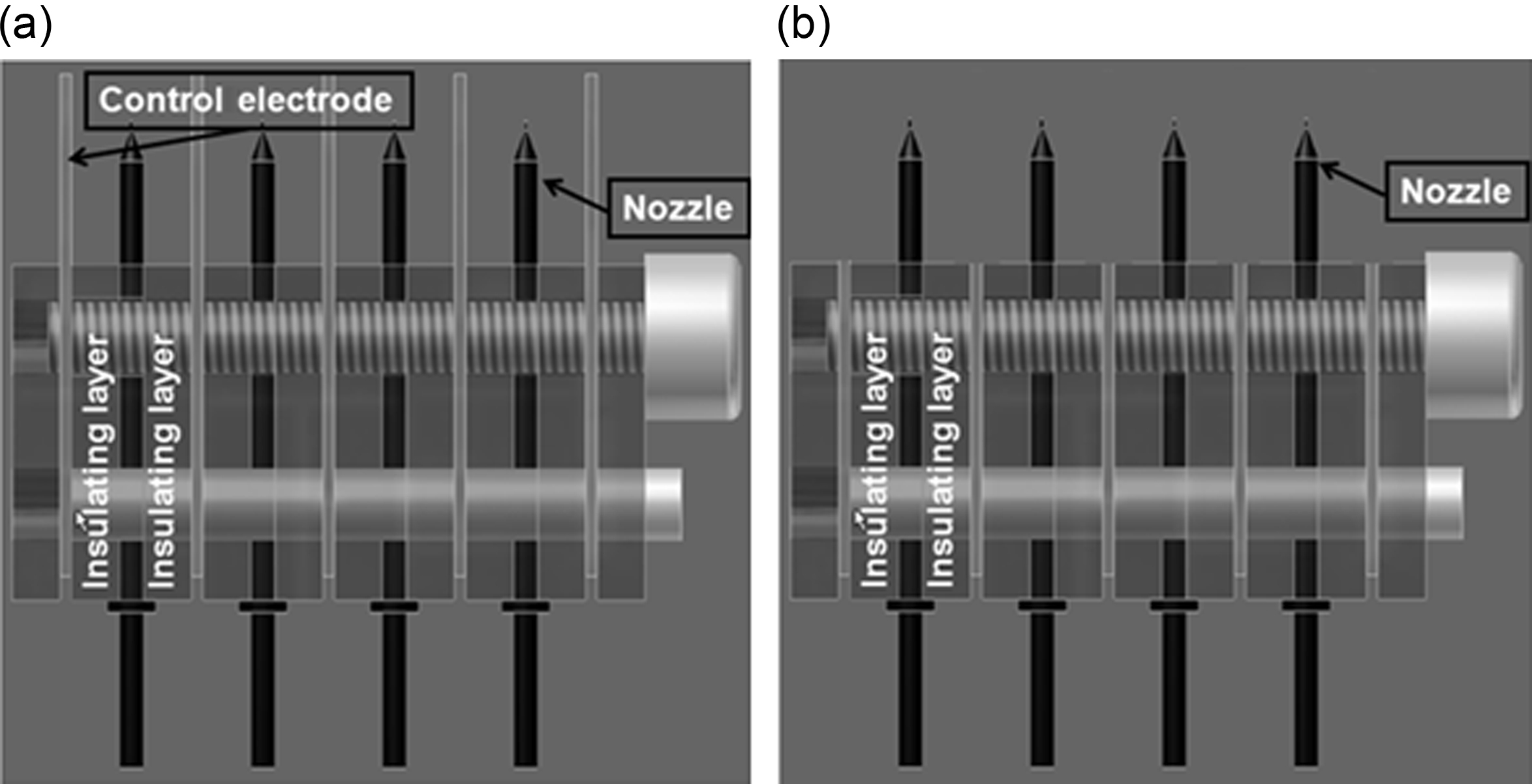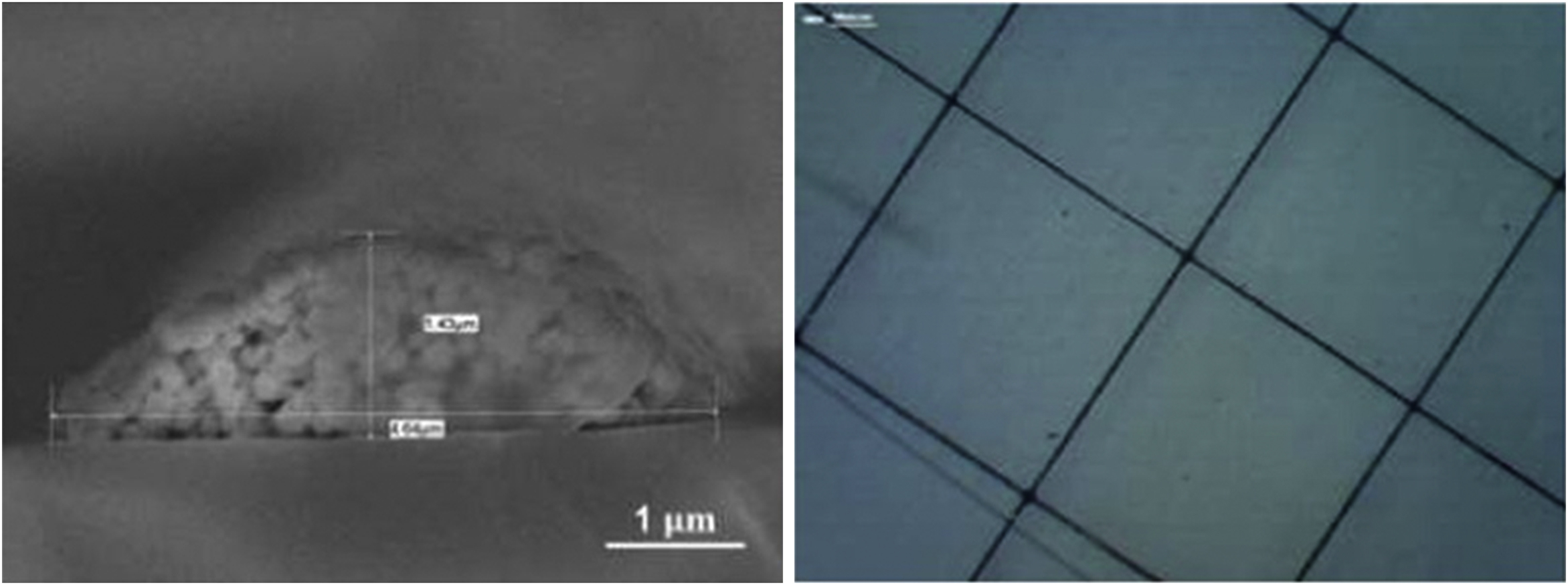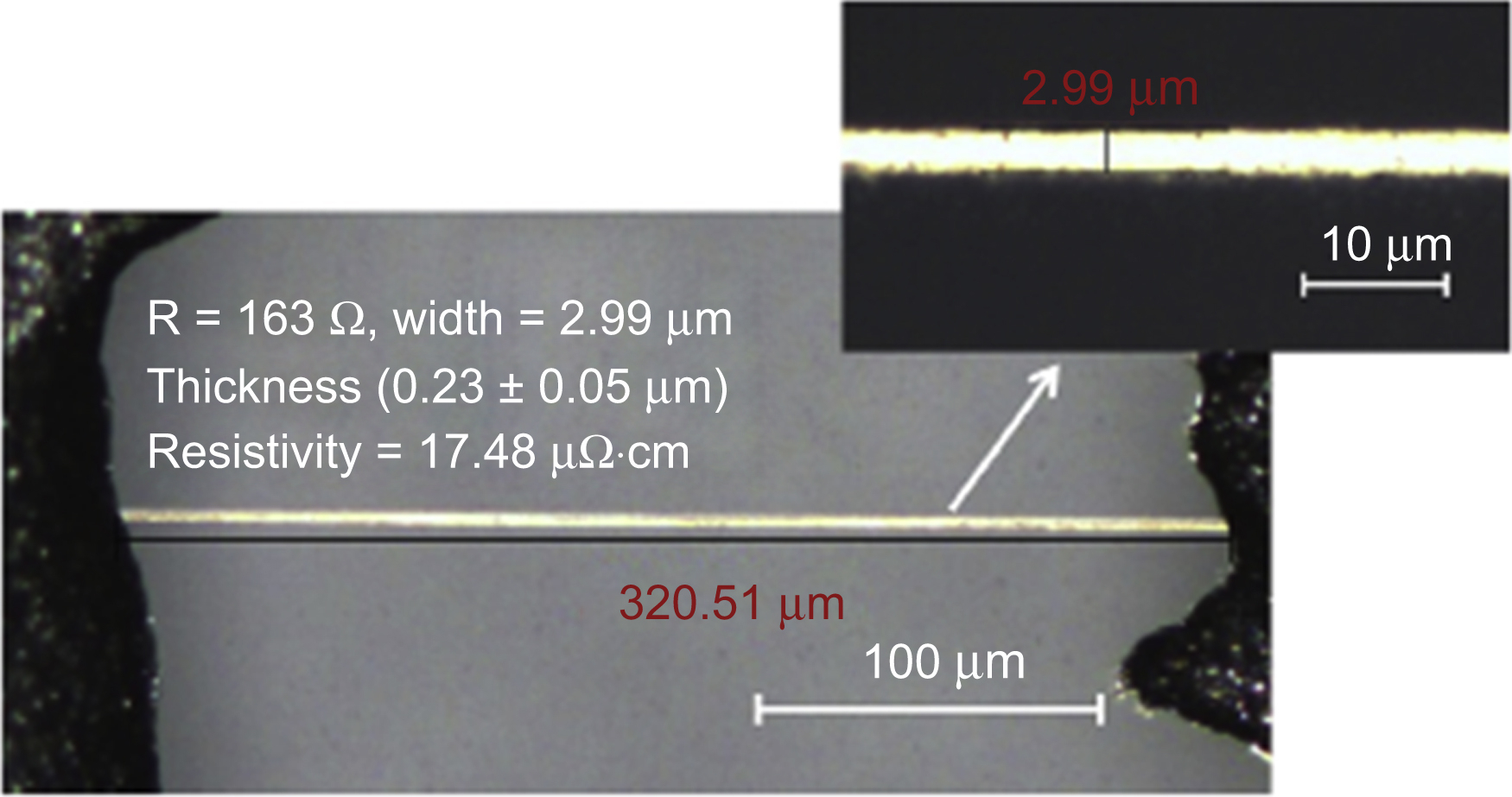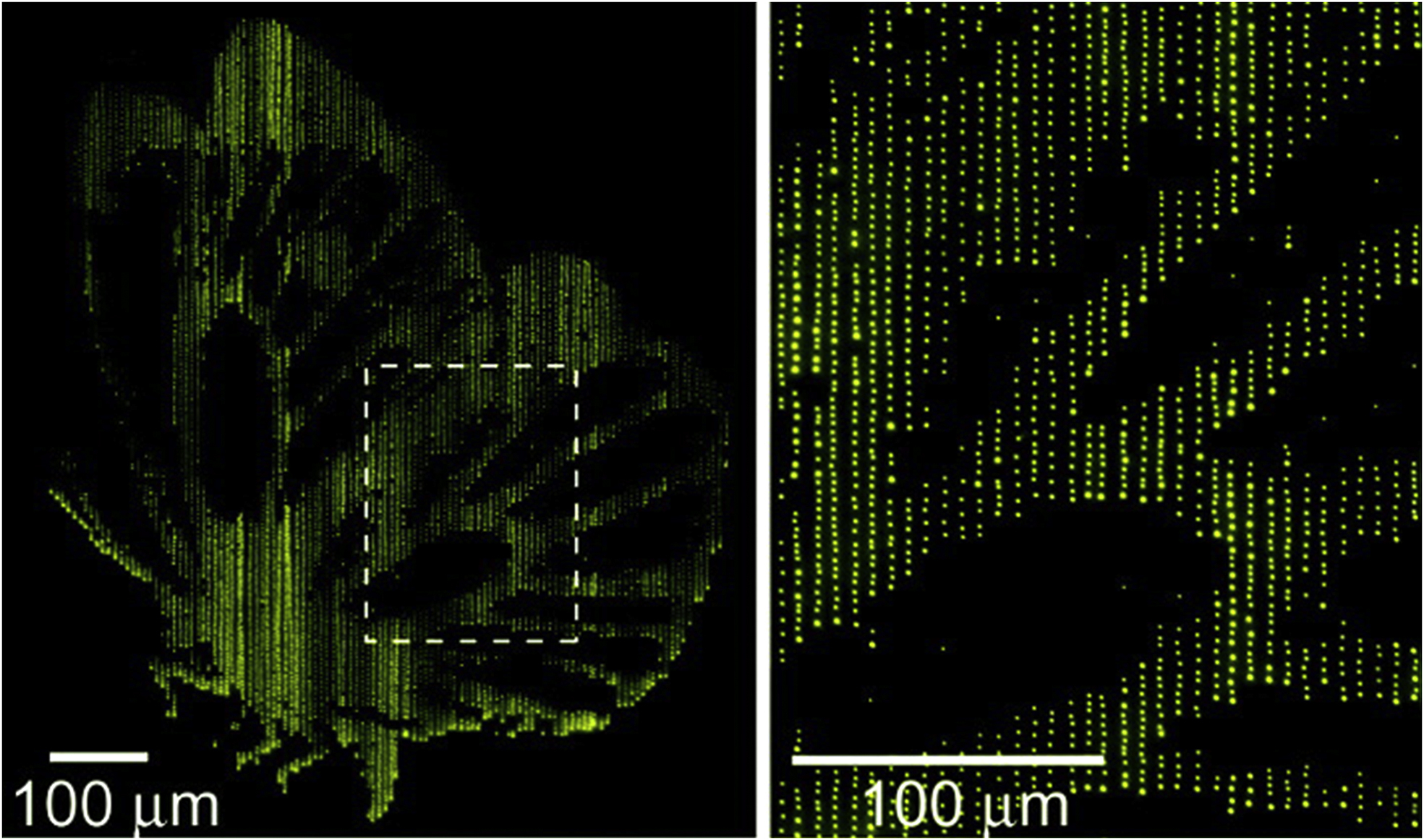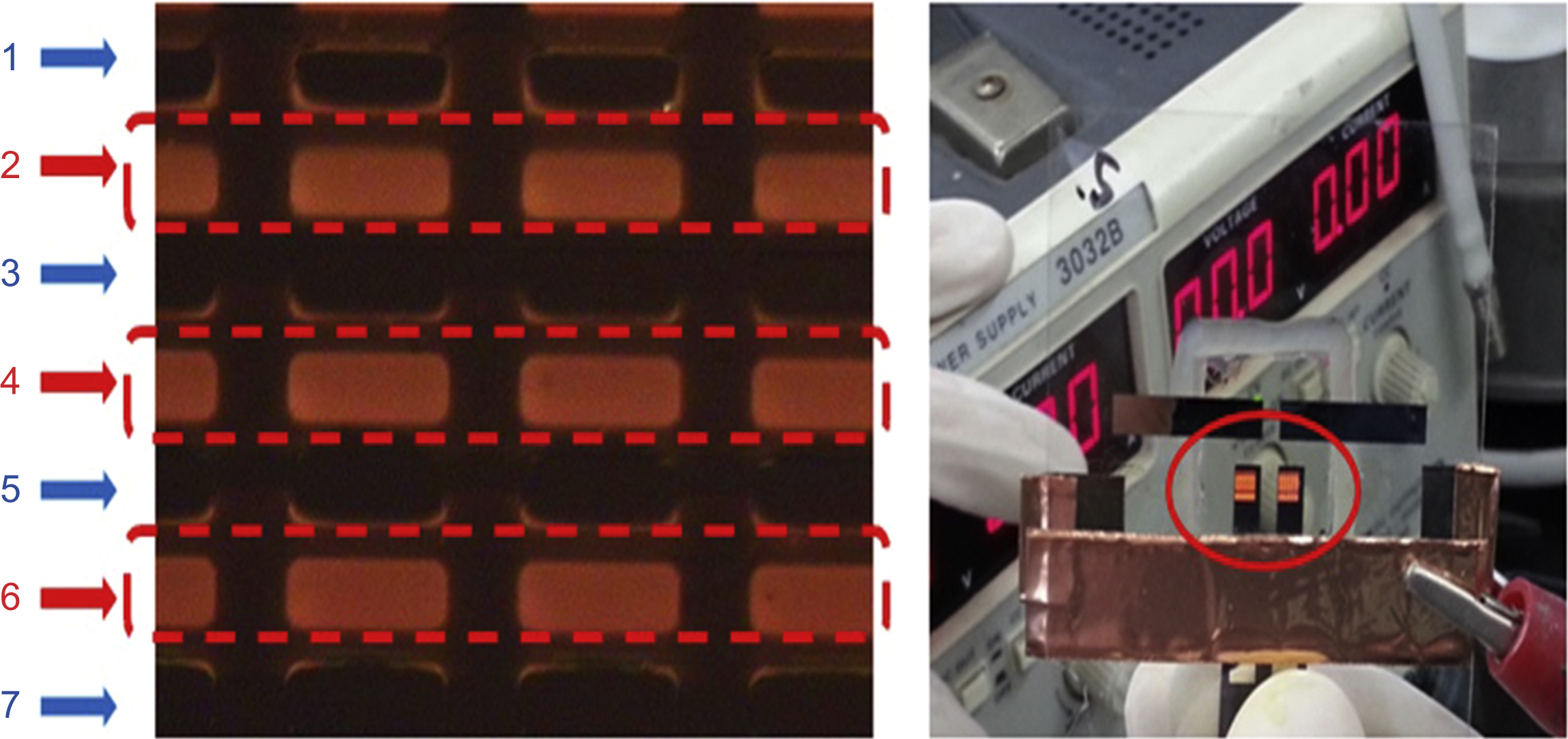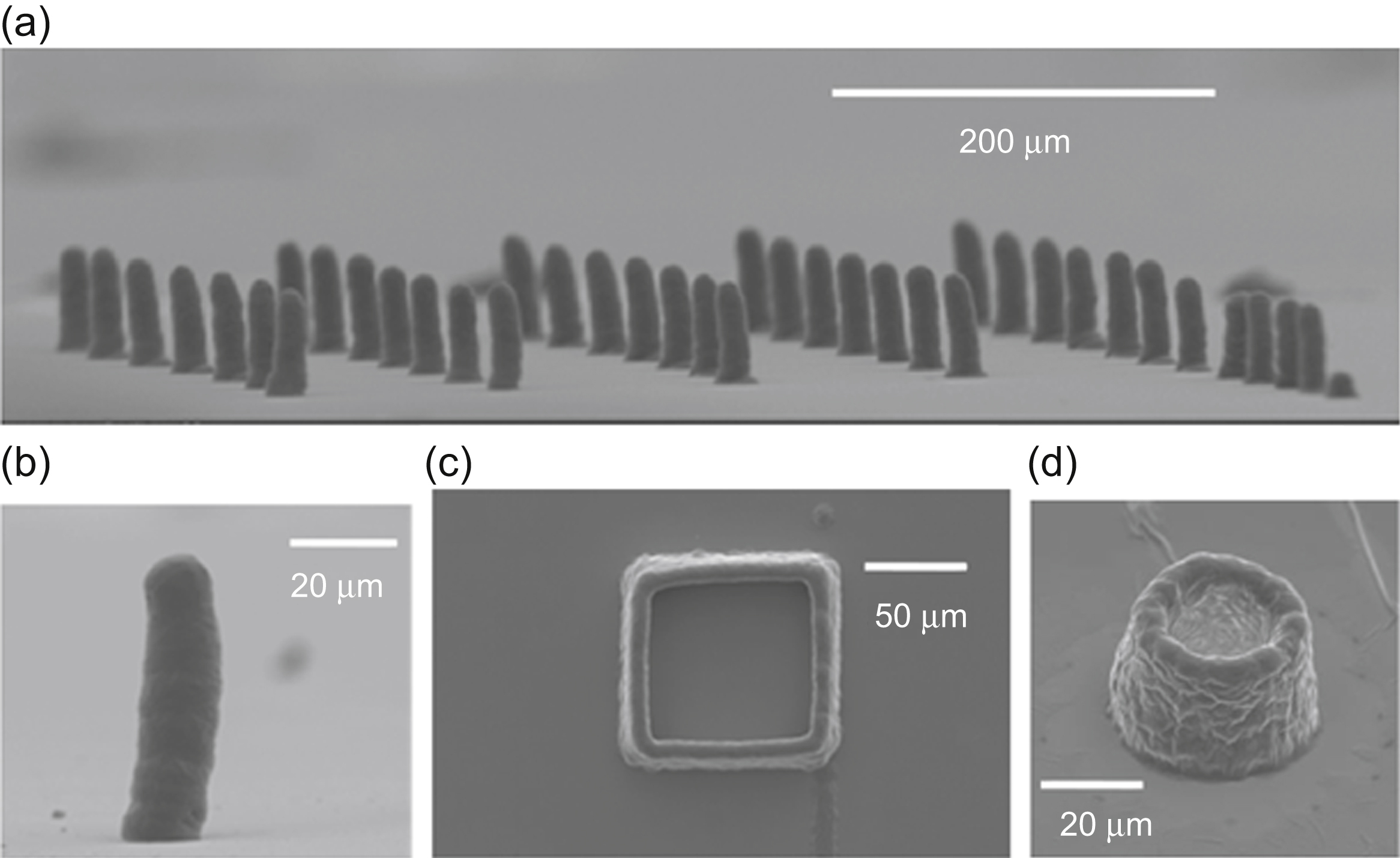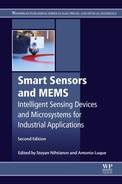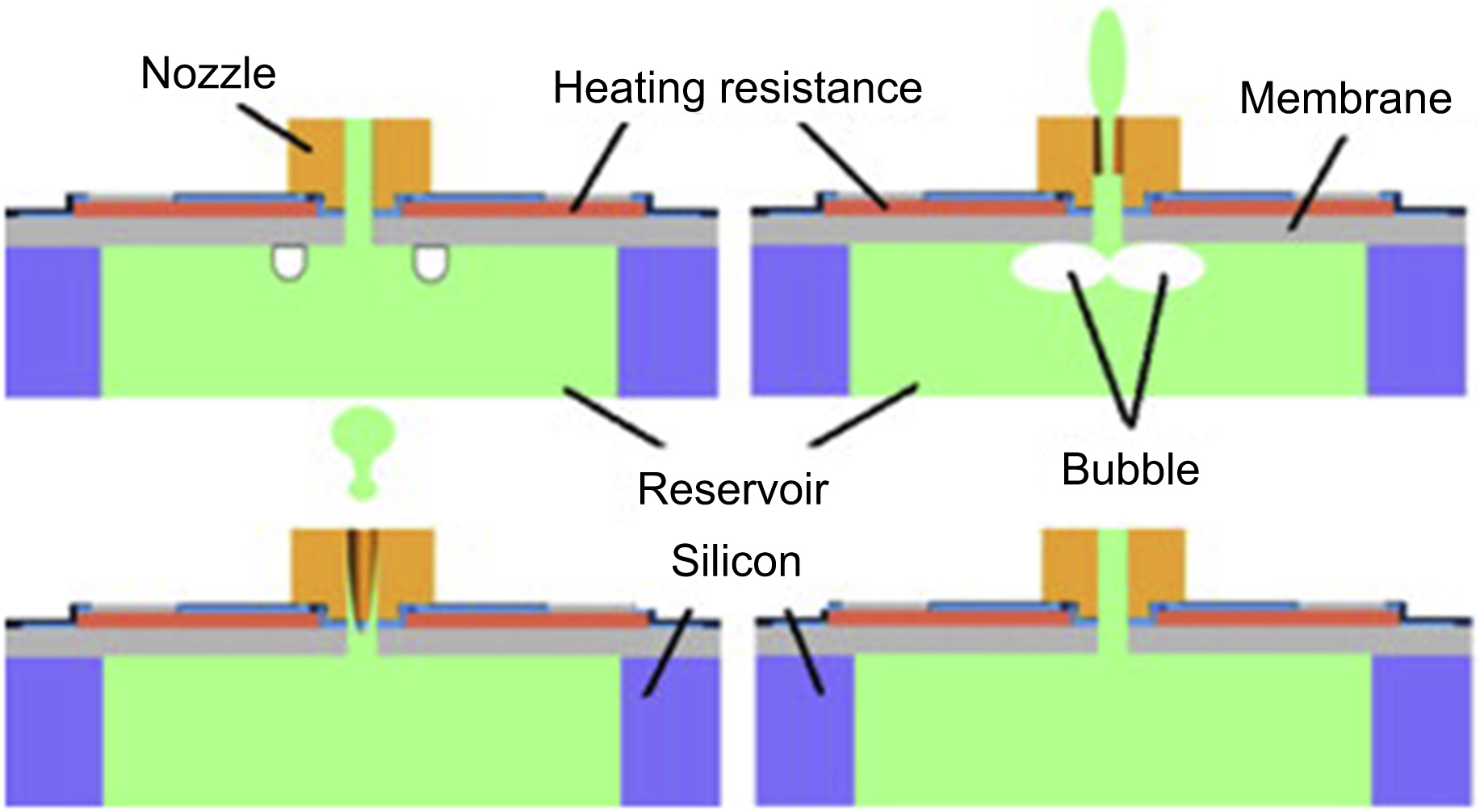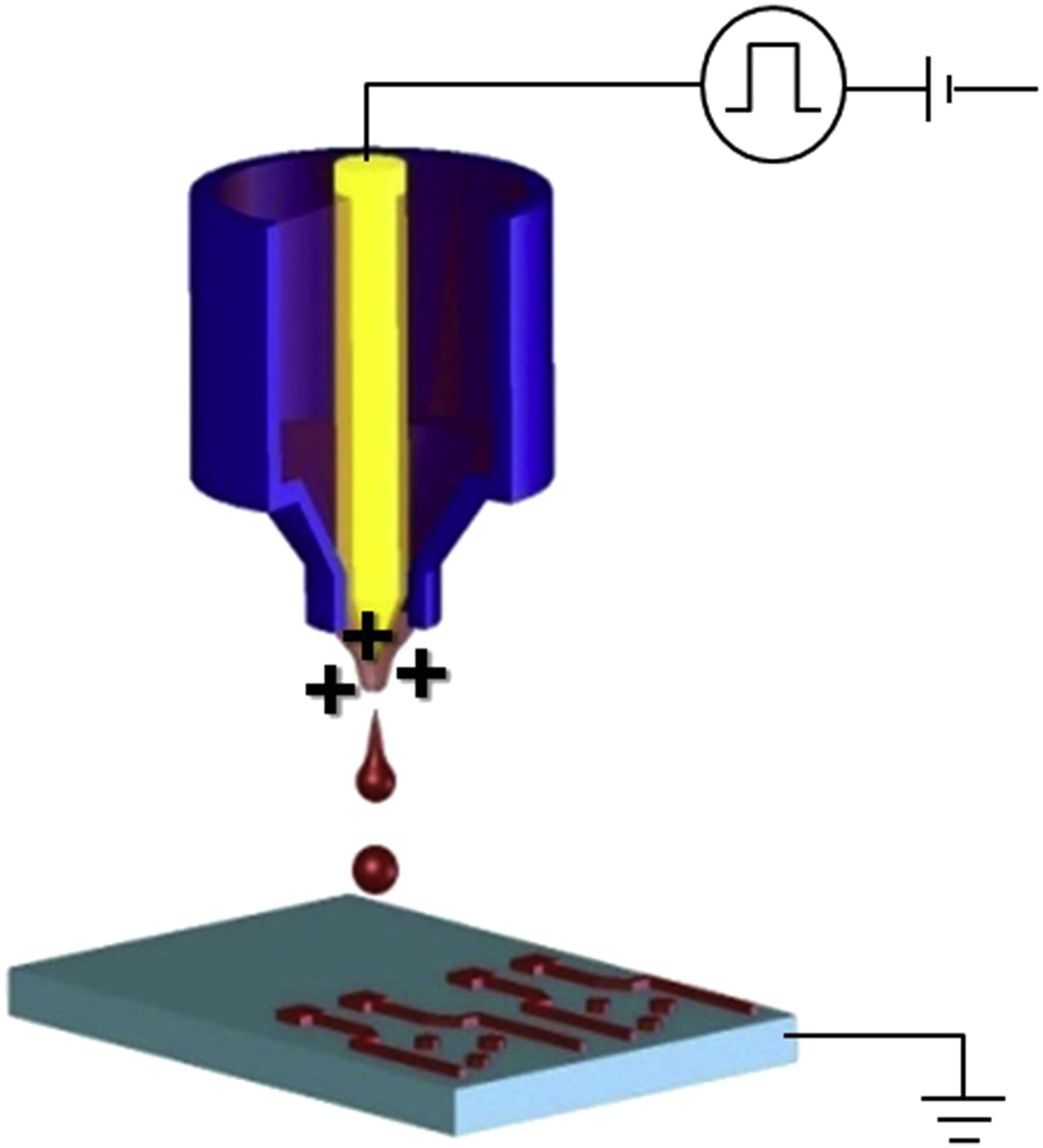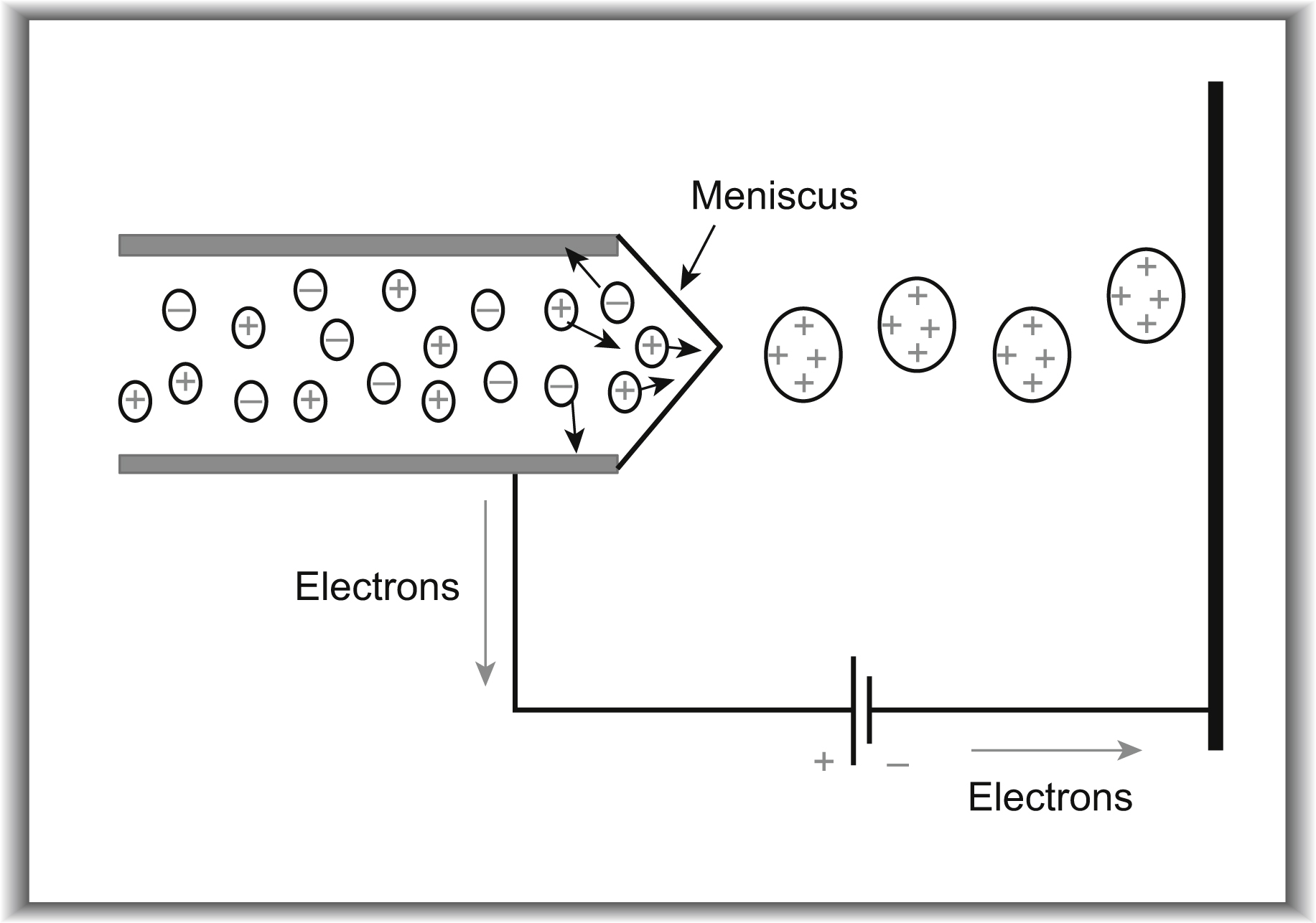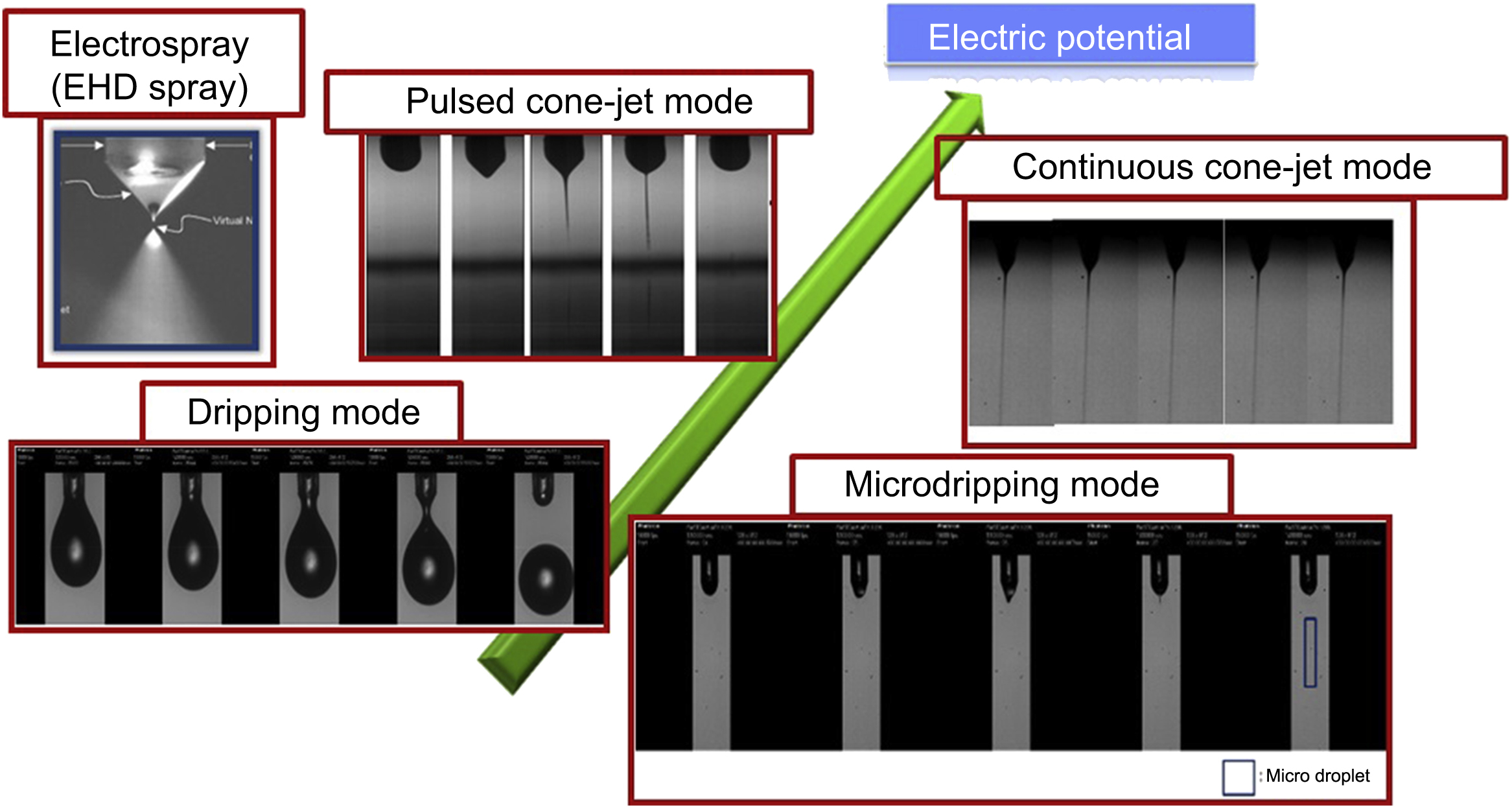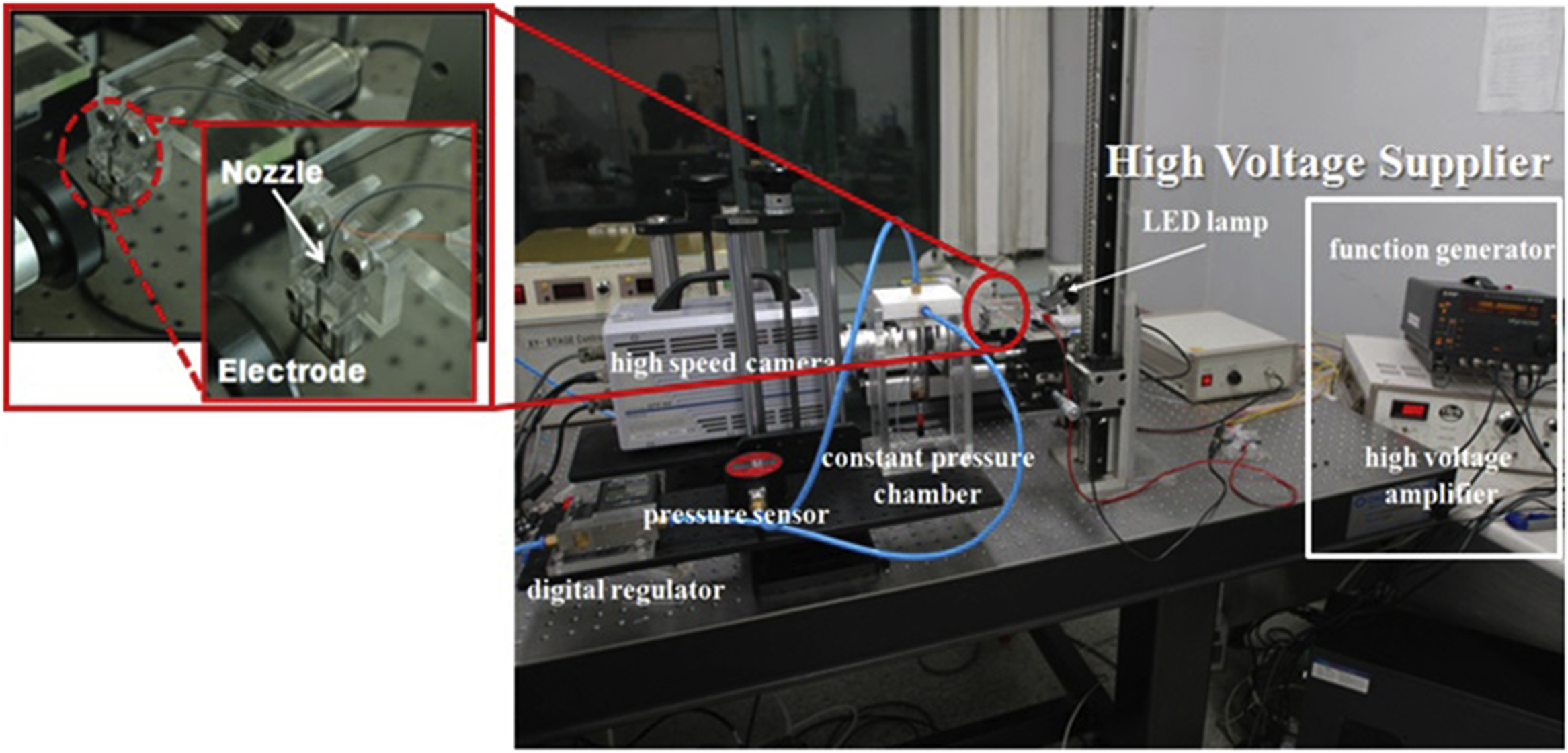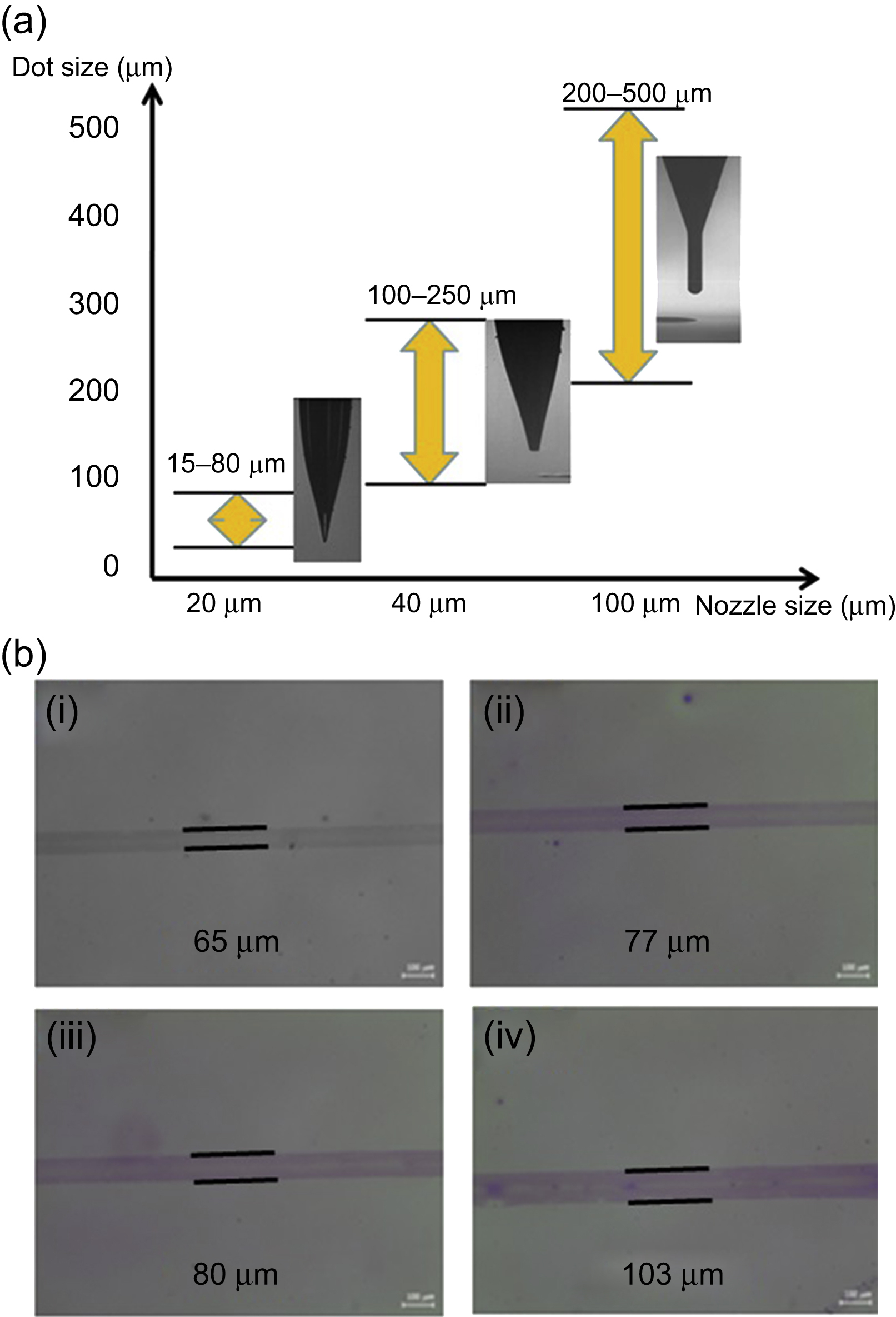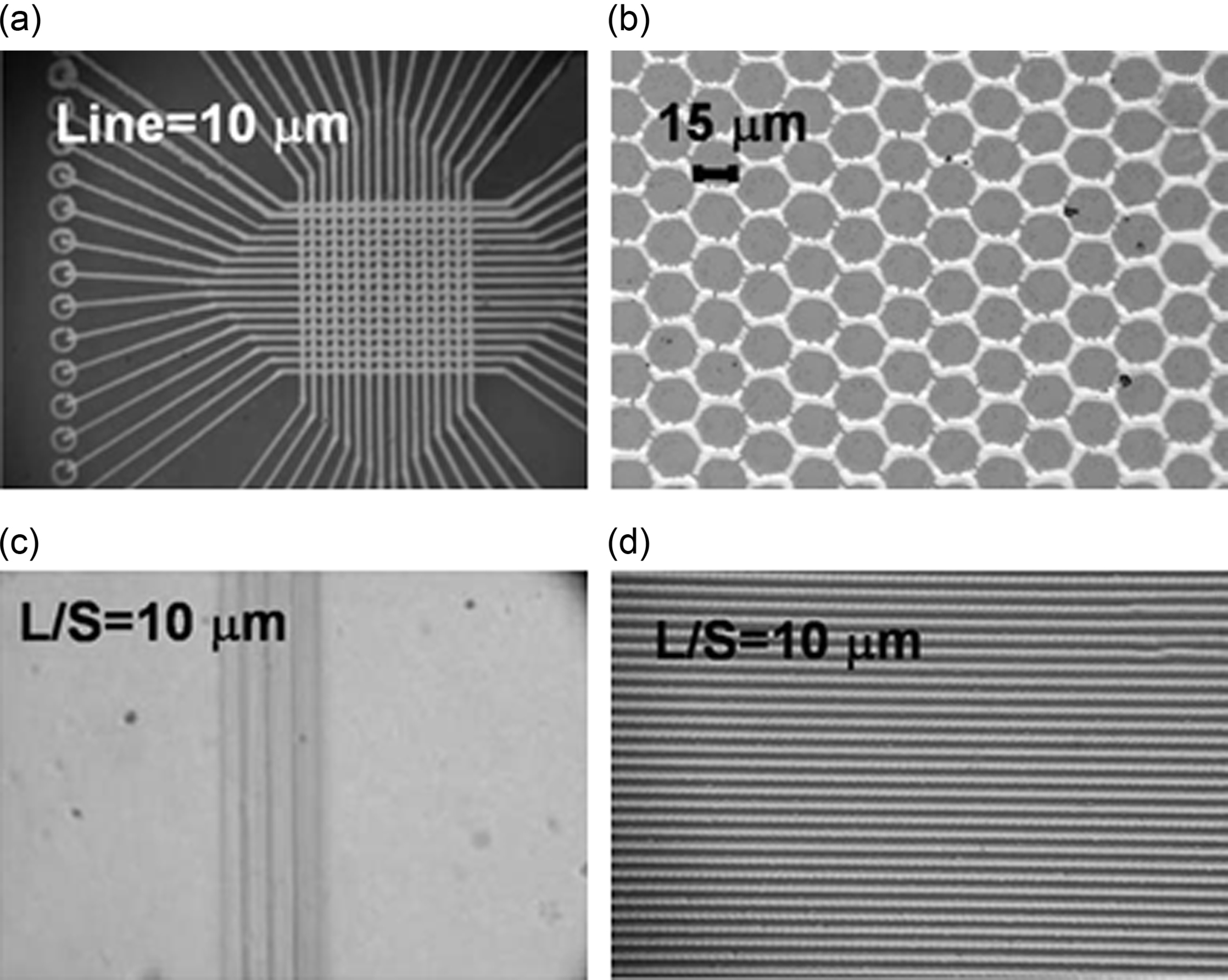Allen R.R, Meyer J.D, Knight W.R. Thermodynamics and hydrodynamics of thermal ink jets. Hewlett-Packard Journal. 1985;36(5):21–27.
An B.W, Kim K, Lee H, Kim S, Shim Y, Lee D, Song J.Y, Park J. High-resolution printing of 3D structures using an electrohydrodynamic inkjet with multiple functional inks. Advanced Materials. 2015;27:4322–4328.
Bharathan J, Yang Y. Polymer electroluminescent devices processed by inkjet printing: I. Polymer light-emitting logo. Applied Physics Letters. 1998;72:2660–2662.
Brünahl J, Grishin A.M. Piezoelectric shear mode drop-on-demand inkjet actuator. Sensors and Actuators A. 2002;101:371–382.
Byun D, Lee Y, Tran S.B.Q, Nguyen V.D, Kim S, Park B, Lee S, Inamdar N, Bau H.B. Electrospray on superhydrophobic nozzles treated with argon and oxygen plasma. Applied Physics Letters. 2008;92:093507.
Calvert P. Inkjet printing for materials and devices. Chemistry of Materials. 2001;13:3299–3305.
Chen P, Chen W, Chang S.H. Bubble growth and ink ejection process of a thermal ink jet printhead. International Journal of Mechanical Science. 1997;39:683–695.
Choi J, Na W, Son S.U, Chae H, Lee S, Chung H.K. High resolution OLED patterning using electrohydrodynamic printing. In: IMID 2013 Digest, the 13th International Metting on Information Display, 26–29 August 2013, Daegu, Republic of Korea. 2013:86.
Choi J, Kim Y, Lee S, Son S.U, Ko H.S, Nguyen V.D, Byun D. Drop-on demand printing of conductive ink by electrostatic field induced inkjet head. Applied Physics Letters. 2008;93:193508.
Choi J, Kim Y, Son S, An K, Lee S. The investigation of electrostatic induced inkjet printing system for the ejection of a stable micro/nano droplet. In: Nanotech 2010 Conference Proceedings, NSTI-Nanotech 2010, 21–24 June 2010, Anaheim, USA. 2010:464–467.
Choi J, Kim Y, Son S, Kim Y.M, Lee S, Byun D.Y, Ko H.S. Pattern characteristic by electrostatic drop-on-demand ink-jet printing using capillary inkjet head system. In: Nanotech 2007 Conference Proceedings, NSTI-Nanotech 2007, 20–24 May 2007, Santa Clara, USA. 2007:403–406.
Cloupeau M, Prunet-Foch B. Electrostatic spraying of liquids: mainfunctioning modes. Journal of Electrostatics. 1990;25:165–184.
Cloupeau M, Prunet-Foch B. Electrohydrodynamic spraying functioning modes: a critical review. Journal of Aerosol Science. 1994;25:1021–1036.
Collins R.T, Jones J.J, Harris M.T, Basaran O.A. Electrohydrodynamic tip streaming and emission of charged drops from liquid cones. Naturephysics. 2007;4:149–154.
Eggers J. Physics of liquid jets. Reports on Progess in Physics. 2008;71:036601.
Ganan-Calvo A.M, Davila J, Barrero A. Current and droplet size in the electrospraying of liquids. Scaling laws. Journal of Aerosol Science. 1997;28:249–275. .
Han Y, Wei C, Dong J. Super-resolution electrohydrodynamic (EHD) 3D printing of micro-structures using phase-change inks. Manufacturing Letters. 2014;2:96–99.
Han Y, Wei C, Dong J. Droplet formation and settlement of phase-change ink in high resolution electrohydrodynamic (EHD) 3D printing. Journal of Manufacturing Processes. 2015;20:485–491.
Han Y, Dong J. Design of integrated ring extractor for high resolution electrohydrodynamic (EHD) 3D printing. Procedia Manufacturing. 2016;5:1031–1042.
Hwang T.H, Kin Y.J, Chung H, Ryu W. Motionless electrohydrodynamic (EHD) printing of biodegradable polymer micro patterns. Microelectronic Engineering. 2016;161:43–51.
Ishida Y, Hakiai K, Matsuzaki K, Baba A, Asano. Electrostatic inkjet patterning using si needle prepared by anodization. Japanese Journal of Applied Physics. 2005;44:5786–5790.
Ishida Y, Sogabe K, Haklai K, Baba A, Asano T. Properties of inkdroplet formation in double-gate electrospray. Japanese Journal of Applied Physics. 2006;45:6475–6480.
Jaworek A, Krupa A. Classification of the modes of EHD spraying. Journal of Aerosol Science. 1999;30:873–893.
Jaworek A, Sobczyk A.T. Electrospraying route to nanotechnology: an overview. Journal of Electrostatics. 2008;66:197–219.
Jayasinghe S.N, Edirisinghe M.J. Electrically forced jets and microthreads of high viscosity dielectric liquids. Aerosol Science. 2004;35:233–243.
Kim K, Kim G, Lee B.R, Ji S, Kim S, An B.W, Song M.H, Park J. High-resolution electrohydrodynamic jet printing of small-molecule organic light-emitting diodes. Nanoscale. 2015;7:13410–13415.
Kim S.Y, Kim K, Hwang Y.H, Park J, Jang J, Nam Y, Kang Y, Kim M, Park H.J, Lee Z, Choi J, Kim Y, Jeong S, Bae B.S, Park J.U. High-resolution electrohydrodynamic inkjet printing of stretchable metal oxide semiconductor transistors with high performance. Nanoscale. 2016;8:17113–17121.
Kim Y.J, Choi J, Son S.U, Lee S, Nguyen X.H, Nguyen V.D, Byun D, Ko H.S. Comparative study on ejection phenomena of droplets from electrohydrodynamic jet by hydrophobic and hydrophilic coatings of nozzles. Japanese Journal of Applied Physics. 2010;49:060217.
Kim Y, Ko H.S, Lee S, Son S.U, Jung D, Byun D. Numerical and experimental analysis of electrostatic ejection of liquid droplets. Journal of the Korean Physical Society. 2007;51:42–46.
Kim Y.J, Lee S, Ko H.S, Choi J, Son S.U, An K.C, Lee S.H. Discharging Nozzle and Electrostatic Field Induction Ink-Jet Nozzle US Patent 8579411 B2. 12 November 2013.
Lastow O, Balachandran W. Numerical simulation of electrohydrodynamic (EHD) atomization. Journal of Electrostatics. 2006;64:850–859.
Le H.P. Progress and trends in ink-jet printing technology. Journal of Imaging Science and Technology. 1998;42:49–62.
Lee D, Shin Y, Park S, Yu T, Hwang J. Electrohydrodynamic printing of silver nanoparticles by using a focused nanocolloid jet. Applied Physics Letters. 2007;90:081905.
Lee S, Byun D, Jung D, Choi J, Kim Y, Yang J.H, Son S.U, Tran S.B.Q, Ko H.S. Pole-type ground electrode in nozzle for electrostatic field induced drop-on-demand inkjet head. Sensors and Actuators. 2008;141:506–514. .
Lee S, Kim Y, Sin J, Son S, An K, Choi J, Lee W.H, Wijesundara M, Stephanou H.E. Array-nozzle EHD print head and its drop-on-demand experimentation. In: Nanotech 2011 Conference Proceedings, NSTI-Nanotech 2011, 13–16 June 2011, Boston, USA. 2011:516–519.
Lee S, An K, Son S, Choi J. Satellite/spray suppression in electrohydrodynamic printing with a gated head. Applied Physics Letters. 2013;103:133506.
Li J.L. EHD spraying induced by the pulsed voltage superimposed to a bias voltage. Journal of Electrostatics. 2007;65:750–757.
Maktabi S, Chiarot P.R. Electrohydrodynamic printing of organic polymeric resistors on flat and uneven surfaces. Journal of Applied Physics. 2016;120:084903.
Mottelay P.F. Bibliographical History of Electricity and Magnetism. London: Charles Griffin & Company Ltd.; 1922.
Murata K, Matsumoto J, Tezuka A, Matsuba Y, Yokoyama H. Superfine ink-jet printing: toward the minimal manufacturing system. Microsystem Technologies. 2005;12:2–7.
Notz P.K, Basaran O.A. Dynamics of drop formation in an electric field. Journal of Colloid and Interface Science. 1999;213:218–237.
Park J.U, Hardy M, Kang S.J, Barton K, Adair K, Mukhopadhyay D.K, Lee C.Y, Strano M.S, Alleyne A.G, Georgiadis J.G, Ferreira P.M, Rogers J.A. High-resolution electrohydrodynamic jet printing. Nature Materials. 2007;6:782–789.
Park J, Lee J.H, Paik U, Lu Y, Rogers J.A. Nanoscale patterns of oligonucleotides formed by electrohydrodynamic jet printing with applications in biosensing and nanomaterials assembly. Nano Letters. 2008;8:4210–4216.
Si B.Q.T, Byun D, Lee S. Experimental and theoretical study of a conejet for an electrospray microthruster considering the interference effect in an array of nozzles. Aerosol Science. 2007;38:924–934.
Singh M, Haverinen H.M, Dhagat P, Jabbour G.E. Inkjet printing–process and its applications. Advanced Materials. 2010;22:673–685.
Sirringhaus H, Kawase T, Friend R.H, Shimoda T, Inbasekaran M, Wu W, Woo E.P. High-resolution inkjet printing of all-polymer transistor circuits. Science. 2000;290:2123–2126.
Smith D.P.H. The electrohydrodynamic atomization of liquids. IEEE Transactions on Industry Application. 1986:527–535 IA-22.
Son S, An K, Kim Y, Choi J, Lee S. Study of the phenomenon of meniscus deformation and ejection by pulse voltage and frequency in drop-on-demand EHD printing. In: NSTI-Nanotech 2010, 21–24 June 2010, Anaheim, USA. 2010:500–503.
Son S, Lee S, Choi J. Repeated duplication in EHD line patterning on a non-conductive substrate based on controlling the polarity of applied voltages. In: NSTI-Nanotech 2013, 12–16 May 2013, Washington DC, USA. 2013:273–276.
Son S, Lee S, Choi J. Fishbone pattern phenomena on a non-conductive substrate in electrohydrodynamic discharging. In: NSTI-Nanotech 2014, 15–18 June 2014, Washington DC, USA. 2014:165–168.
Son S, Lee S, Choi J. Fine metal line patterning on hydrophilic non-conductive substrates based on electrohydrodynamic printing and laser sintering. Journal of Electrostatics. 2014;72:70–75.
Wijshoff H. The dynamics of the piezo inkjet printhead operation. Physics Reports. 2010;491:77–177.
Wilhelm O. Electrohydrodynamic Spraying – Transport, Mass and Heat Transfer of Charged Droplets and Their Application to the Deposition of Thin Functional Films (Ph.D. dissertation). University of Tübingen; 2004. .
Yang S.M, Lee Y.S, Jang Y, Byun D, Choa S. Electromechanical reliability of a flexible metal-grid transparent electrode prepared by electrohydrodynamic (EHD) jet printing. Microelectronics Reliability. 2016;65:151–159.
Youn D, Kim S, Yang Y, Lim S, Kim S, Ahn S, Sim H, Ryu S, Shin D, Yoo J. Electrohydrodynamic micropatterning of silver ink using near-field electrohydrodynamic jet printing with tilted-outlet nozzle. Applied Physics A. 2009;96:933–938.
Zeleny J. The electrical discharge from liquid points, and a hydrostatic method of measuring the electric intensity at their surface. Physical Review. 1914;3:69–91.
Zeleny J. Instability of electrified liquid surfaces. Physical Review. 1917;10:1–6.
Zhou H, Gué A.M. Simulation model and droplet ejection performance of a thermal-bubble microejector. Sensors and Actuators B. 2010;145:311–319.
